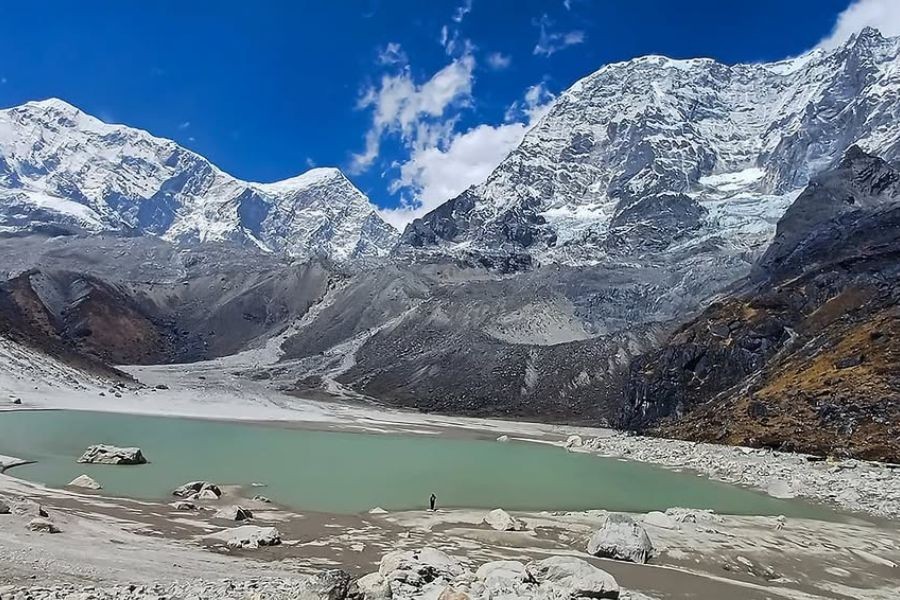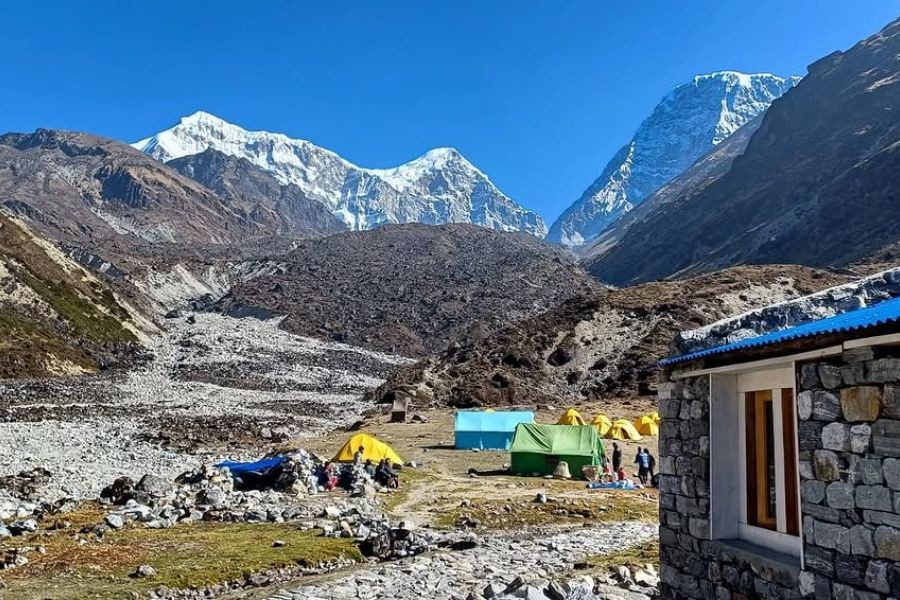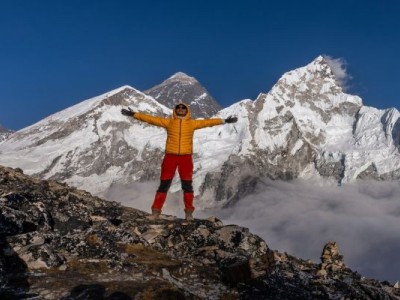Overview of Pikey Peak Trek
Highlights and Best Viewpoints
Standing at 4,065 meters, Pikey Peak trek has one of the most stunning 360-degree views of the Himalayan range. Sir Edmund Hillary once said that Pikey Peak shows the best view of Mount Everest. From the top, trekkers get spectacular views in all directions that include Everest, Makalu, Kanchenjunga, Lhotse, and Nuptse.
The view of the sunrise from Pikey is exceptionally breathtaking as the first rays strike the Himalayan peaks in gold and crimson. Pikey Peak is an easier trek than the higher-altitude, smaller treks, Everest Base Camp trek or the Gokyo Lakes, while still showcasing magnificent vistas.
Trail Experience and Cultural Encounters
The path curves through a variety of landscapes that include terraced farmlands, rhododendron woods, and alpine meadows with yak pastures. Trekkers will walk through traditional Sherpa villages, like Junbesi, Phaplu, and Taksindu, where life goes on just like it has for hundreds of years. You'll visit monasteries that are hundreds of years old, like Thupten Chholing and Taksindu Monastery, where you'll be able to experience the cultural customs of the region. You'll see more locals than trekkers, and compared to other popular trails and bases like Annapurna Base Camp or Ghorepani Poon Hill, you're bound to run into much fewer fellow trekkers.
Overview of Dudhkunda Lake Trek

Significance of Dudhkunda (Sacred Milk Lake)
Dudhkunda translates to "Milk Lake" and is a holy high-altitude lake at around 4,560 meters. This clear body of water has immense religious significance to both Hindu's and Buddhists. The story goes that Lord Shiva formed the lake by striking the mountain with his trident, and the milky pond holds medicinal properties.
Every year, thousands of pilgrims take a laborious journey to ultimately dip in Dudhkunda's sacred waters teach August during the festival of Janai Purnima.
Scenic Landscapes and Remote Villages
The trek to Dudhkunda Lake takes you through some of the last pristine wilderness areas of the Lower Everest region. The trails wind their way through heavy forests of rhododendron, bamboo, and pine trees, which come to life with color during the springtime. You will also see isolated Sherpa and Rai villages such as Ringmo, Saharsbeni, and Basa, where traditional lifestyles are being maintained. These villages are far from the more popular trekking hubs of Namche Bazaar or Lukla, which will help you gain a more authentic cultural experience.
Why Combine Both Treks?
Shared Route and Connection Points
A strong argument for the combination of Pikey Peak and Dudhkunda trek is the proximity of their locations. They both start from a similar starting point on the Solu side of the trekking area, usually starting from Phaplu or Salleri. After reaching the summit of Pikey Peak, the trek to Dudhkunda Lake is easily accessible by continuing eastward along trails that connect with each other and do not require nearly as much backtracking.
Benefits of the Combined Itinerary
These two treks have great value packed in, taking in multiple environments and cultural experiences in just over 10 - 14 days. Combining the two treks provides a better opportunity for acclimatization from lower altitudes to the altitude of Pikey Peak (4,065m) to Dudhkunda (4,560m) and minimizes the risk of altitude sickness. The Pikey Peak Dudhkunda combined trek maximizes cultural experiences and is an alternative best short trek in the Everest region, offering climbing the bigger mountains without the altitude impacts.
Trek Itinerary: Pikey Peak and Dudhkunda Combined Route
Day 1: Kathmandu to Phaplu (2,469m) – Drive 6-7 hours through terraced hillsides and rural villages.
Day 2: Phaplu to Jhapre (2,815m) – Trek 5-6 hours through forests and Sherpa villages.
Day 3: Jhapre to Pikey Base Camp (3,640m) – Trek 5-6 hours through alpine forests and yak pastures.
Day 4: Summit Pikey Peak (4,065m) and Trek to Junbesi (2,680m) – Early morning summit climb for sunrise views, then descend to Junbesi (7-8 hours total).
Day 5: Junbesi to Phuleli/Basa (2,850m) – Trek 6-7 hours eastward through forests and farmlands.
Day 6: Phuleli to Saharsbeni (3,100m) – Trek 5-6 hours through increasingly remote terrain.
Day 7: Saharsbeni to Dudhkunda Lake (4,560m) and return – Challenge day with 7-8 hours trekking to the sacred lake and back.
Day 8: Saharsbeni to Ringmo (2,720m) – Descend 5-6 hours through forests and villages.
Day 9: Ringmo to Phaplu (2,469m) – Final trekking day, 4-5 hours back to Phaplu.
Day 10: Phaplu to Kathmandu – Return drive 6-7 hours.
Best Time to Do Pikey Peak and Dudhkunda Trek

The best time to do the Pikey Peak and Dudhkunda trek depends on your priorities:
Spring (March-May) is stable and clear, perfect for mountain viewing. The forests of rhododendron bloom spectacularly. It is less crowded than the autumn with popular routes like Everest Base Camp.
Autumn (September-November) is the peak season with pristine blue skies, optimum visibility, and stable weather. It is a comfortable temperature, but tends to be a bit cold at night at higher elevations. Popular routes such as the Annapurna Circuit begin to get crowded, whilst the quieter trails such as Pikey Peak Dudhkunda are less so.
Winter (December-February) is difficult, but far fewer trekkers and the views are stunningly clear. The temperature drops sharply, and snow can block passes. It is better for experienced trekkers.
Monsoon (June-August) is generally not a good time to do treks because of the heavy rains inhibiting views. However, the Janai Purnima festival also occurs at Dudhkunda during this time.
The best times to trek are mid-March to mid-May, and mid-September to mid-November.
Difficulty Level and Physical Preparation
The combined trek is rated moderate to moderately difficult; it is easier than Ghorepani Poon Hill, but more difficult than the Everest Base Camp or Three Passes Trek. The maximum altitude will be 4,560 meters, so you must acclimatize properly. The trek will take 10-14 days, and you should expect to walk for 5-8 hours each day.
Physical Preparation: We suggest that you commence training publicly 2-3 months before your departure. We recommend training for cardiovascular fitness 4-5 times per week for 45-60 minutes (hiking, running, cycling). Leg strength through squats and lunges. Pre-complete practice hikes while carrying a backpack (8-10 kg).
Awareness of Altitude: Altitude sickness can happen to anyone. Symptoms can include headache, nausea, and dizziness. You can avoid altitude sickness by gradually ascending in altitude, drinking 3-4 liters of water a day, and no alcohol. We recommend that you check that your travel medical insurance covers high-adventure trekking and helicopter evacuation.
Accommodation and Food Options
Teahouse Lodges: In large villages, basic lodges offer basic rooms with two beds and shared bathrooms. The rooms do not have heat, but blankets are available. Dining rooms are warmed by stoves.
Homestays: In remote areas, mostly around Dudhkunda, homestays offer an authentic cultural experience. The accommodations are basic, but the hospitality is great.
Food choices: The usual foods are dal bhat (rice with lentils), fried rice, noodle soup, momos, eggs, and porridge. Vegetarian food is freely available. Dal bhat can be highly recommended as fresh nourishment, offered with unlimited refills.
Permits and Trekking Requirements
Required Permits:
- Khumbu Pasang Lhamu Rural Municipality Entry Permit: ~2,000 NPR
- Gaurishankar Conservation Area Permit: ~3,000 NPR
- TIMS Card: May be required (~2,000 NPR)
Additional Requirements: A valid passport, Nepal visa, and travel insurance for trekking to 6000 meters with helicopter evacuation are required. It is very advisable to use a local guide who provides safety and culture. The rates for local guides range from $25 USD to $35 USD per day. Trekking agencies in Kathmandu can take care of all the permits as needed.
How to Reach the Starting Point
Overland Drive: Traveling from Kathmandu to Phaplu can take anywhere from 8-10 hours, covering a distance of approximately 280 kilometers. Expect to pay about $100-150 USD if taking a private vehicle or $25-35 USD on a shared form of transport. The road is scenic, but can sometimes be difficult to travel. It passes through places like Dhulikhel, Khurkot, and Salleri.
Alternatively, there are flights available from Kathmandu to Phaplu in small airplanes that take about 35 minutes and run anywhere from $150-200 USD. There are many weather-related risks involved with flying. Plan for potential adverse weather and, when possible, arrange flexible scheduling to minimize complications.
Note: some itineraries begin on this excursion from Salleri. This may allow for comparably improved routes to travel through better access to roads.
Tips for a Successful Combined Trek
Essential Packing: Be sure to bring a set of layering clothing (thermal base layers, fleece, waterproof shell), trekking boots, sleeping bag (-10°C), trekking poles, headlamp, sunglasses, sunscreen, water purification system, and first aid kit.
Acclimating: Go high, slow, drink adequate amounts of water, eat good food, and pay attention to the signs inside yourself that help you recognize potential altitude sickness. Walk slowly and rest adequately.
Eco-Friendly Practices: Pack in and pack out all trash, refill your water bottles, show respect for the local culture, stay on the trails, and use biodegradable items. Purchase from shops that will promote the local economy.
Cultural Respect: Be sure to take off your shoes before entering homes and monasteries, walk in a clockwise direction around any Buddhist site, dress conservatively, and always make sure you ask permission to take a photo of any Indigenous person.
FAQs
How difficult is this trek compared to Everest Base Camp?
It's less challenging in terms of altitude, ranging from a maximum of 4,560 m to 5,364 m. The trek is more isolated, and while it has basic facilities, it's still ideal for fit trekkers with a little trekking experience.
Is altitude sickness a concern?
Yes, although not as high-risk as other treks with altitudes higher than this trek. Your itinerary has some time allocated for acclimatization. The amount of fluid taken on board is very important, trekking slowly up-hill, and if you have any symptoms that worsen, descend immediately with as little exertion as possible.
What permits are required?
The permits for trekking in the Gaurishankar Conservation area are the Khumbu Pasang Lhamu Rural Municipality Entry Permit, the Gaurishankar Conservation Area Permit, and possibly the TIMS card.
What are the trekking costs?
If you go independent trek, it will cost around $25-35 US per day. If you go with a full package with agencies, the prices range from around $800-1500 US dollars per person, depending on the facilities offered by the agencies.
Would you recommend the trek for a solo female traveler?
Yes, with an asterisk! The trekking population is relatively safe, but we would recommend having a guide for your safety, which will assist you in navigating through the trek itself. Dress conservatively and stay at guest houses that have already been established.
Conclusion: Experience the Essence of the Lower Everest Region
The Combined Pikey Peak and Dudhkunda Trek showcases everything awesome about trekking in the Himalayas-exceptional mountain scenery, immersive cultural experiences, and simply being away from the tourist trails. Yes, crowds go to Everest Base Camp and Annapurna Base Camp, but in Solukhumbu you can find the same jaw-dropping scenery without the commercialism of those popular routes.
On this journey, especially when you stand on Pikey Peak at sunrise and watch the light hitting Mount Everest and thousands of other peaks, you will appreciate why this spot is so special. This is enhanced by the fact that the trek to Dudhkunda Lake, which you get to after Pikey Peak, has a spiritual aspect to it, as the combination of the natural beauty and sacred significance elevates the experience. You will also encounter genuine Sherpa hospitality and authentic cultural experiences along the way for the whole experience.
This Pikey Peak Dudhkunda package is only a 10-14-day commitment, making it a possibility for those with a limited timeframe for travel. By selecting this excellent short trek in the Everest region alternative, you will also balance the tourism benefits in communities that do not see as much tourism and wilderness protection. With a unique mix of accessibility and adventure, cultural immersion and natural beauty - even if you are an experienced trekker or this is your first time in the Himalaya, this adventure trekking in Solukhumbu is well conceived.
The hidden gems of Pikey Peak and Dudhkunda are close, just waiting to show you why Nepal is the best place for mountain lovers.
Make an inquire to trek this combine Pikey Peak Dudhkunda trek with Himalayan Ecological Trekking!
Inquire Now: [email protected]
Expert Consultation: WhatsApp: +977 9851006023 (Bikesh)





